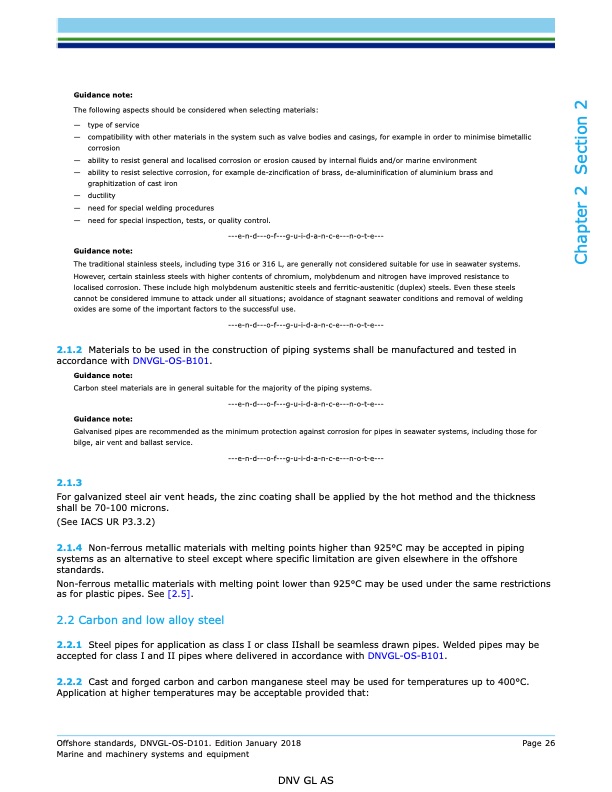
PDF Publication Title:
Text from PDF Page: 026
Guidance note: The following aspects should be considered when selecting materials: — type of service — compatibility with other materials in the system such as valve bodies and casings, for example in order to minimise bimetallic corrosion — ability to resist general and localised corrosion or erosion caused by internal fluids and/or marine environment — ability to resist selective corrosion, for example de-zincification of brass, de-aluminification of aluminium brass and graphitization of cast iron — ductility — need for special welding procedures — need for special inspection, tests, or quality control. ---e-n-d---o-f---g-u-i-d-a-n-c-e---n-o-t-e--- Guidance note: The traditional stainless steels, including type 316 or 316 L, are generally not considered suitable for use in seawater systems. However, certain stainless steels with higher contents of chromium, molybdenum and nitrogen have improved resistance to localised corrosion. These include high molybdenum austenitic steels and ferritic-austenitic (duplex) steels. Even these steels cannot be considered immune to attack under all situations; avoidance of stagnant seawater conditions and removal of welding oxides are some of the important factors to the successful use. ---e-n-d---o-f---g-u-i-d-a-n-c-e---n-o-t-e--- 2.1.2 Materials to be used in the construction of piping systems shall be manufactured and tested in accordance with DNVGL-OS-B101. Guidance note: Carbon steel materials are in general suitable for the majority of the piping systems. ---e-n-d---o-f---g-u-i-d-a-n-c-e---n-o-t-e--- Guidance note: Galvanised pipes are recommended as the minimum protection against corrosion for pipes in seawater systems, including those for bilge, air vent and ballast service. ---e-n-d---o-f---g-u-i-d-a-n-c-e---n-o-t-e--- 2.1.3 For galvanized steel air vent heads, the zinc coating shall be applied by the hot method and the thickness shall be 70-100 microns. (See IACS UR P3.3.2) 2.1.4 Non-ferrous metallic materials with melting points higher than 925°C may be accepted in piping systems as an alternative to steel except where specific limitation are given elsewhere in the offshore standards. Non-ferrous metallic materials with melting point lower than 925°C may be used under the same restrictions as for plastic pipes. See [2.5]. 2.2 Carbon and low alloy steel 2.2.1 Steel pipes for application as class I or class IIshall be seamless drawn pipes. Welded pipes may be accepted for class I and II pipes where delivered in accordance with DNVGL-OS-B101. 2.2.2 Cast and forged carbon and carbon manganese steel may be used for temperatures up to 400°C. Application at higher temperatures may be acceptable provided that: Offshore standards, DNVGL-OS-D101. Edition January 2018 Page 26 Marine and machinery systems and equipment DNV GL AS Chapter 2 Section 2PDF Image | Marine and machinery systems and equipment 2018

PDF Search Title:
Marine and machinery systems and equipment 2018Original File Name Searched:
DNVGL-OS-D101.pdfDIY PDF Search: Google It | Yahoo | Bing
Development of a solar powered Electric Ship The Electricship website originally started off as a project to develop a comprehensive renewable, affordable, modular electric ship... More Info
Modular Boat Hull Composite The case for a unsinkable, modular composite hybrid boat hull... More Info
MS Burgenstock Hybrid Electric Catamaran Lake Lucerne Unique shuttle servicing Lucerne to the Burgenstock Resort... More Info
Ground Power Unit GPU Powered by Lithium Ion Batteries The goal of the Ground Power Unit is to provide a readily accessible, modular, ready-to-power solution for remote power... More Info
| CONTACT TEL: 608-238-6001 Email: greg@electricship.com | RSS | AMP |